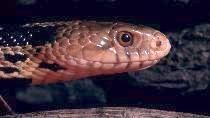
LINKS
Adopt-A-Pond site for building a frog pond
Common Mudpuppy Necturus maculosus
American Toad Bufo americanus americanus
Common Snapping Turtle Chelydra serpentina
Five-lined Skink Eumeces fasciatus
Eastern Gartersnake Thamnophis sirtalis sirtalis
Main Menu
Site Map & Links
Rattlesnake page
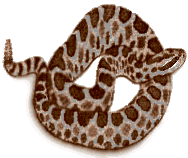
scarce
common
Western Chorus Frog Pseudacris triseriata
common
Northern Leopard Frog Rana pipiens
frequent
Green Frog Rana clamitans melanota
common
Bullfrog Rana catesbeiana
scarce
common
Common Musk Turtle Sternotherus odoratus
rare
Midland Painted Turtle Chrysemys picta marginata
common
Red-eared Slider Trachemys scripta elegans
frequent
Map Turtle Graptemys geographica
scarce
Blanding's Turtle Emydoidea blandingi
scarce
Eastern Spiny Softshell Apalone spinifera spinifera
rare
extirpated
common
Butler's Gartersnake Thamnophis butleri
frequent
Northern Water Snake Nerodia sipedon sipedon
scarce
Northern Red-bellied Snake Storeria occipitomaculata occipitomaculata
frequent
Northern Brownsnake Storeria dekayi
common
Smooth Greensnake Liochlorophis vernalis
rare
Eastern Foxsnake Elaphe gloydi
frequent
Eastern MilksnakeLampropeltis triangulum
rare
Eastern Massasauga Sistrurus catenatus catenatus
rare
AMPHIBIANS & REPTILES of the Ojibway Prairie Complex

AMPHIBIANS
COMMON MUDPUPPY
This large aquatic salamander is found in the Detroit River. They are regularly caught by people ice fishing in shallow water during late winter. The young (photo below) are distinctly striped.
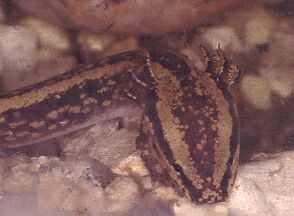
AMERICAN TOAD
Toads breed in shallow sunny ponds and ditches throughout the area and their trilling song can be heard in April and May. The newly transformed "toadlets" can be found in July. During periods of dry weather, the adults remain buried under logs and leaf litter.
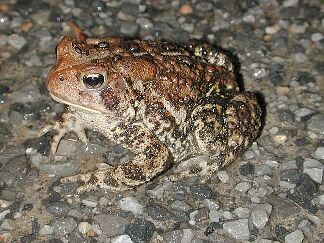
WESTERN CHORUS FROG
The first warm spell in late March brings a "chorus" of vibrant song from every ditch and puddle. This tiny frog, only an inch in length, is rarely seen after the breeding season ends in late April.
A similar species, Spring Peeper, was recorded from nearby LaSalle in 2007 but its origins are unclear.
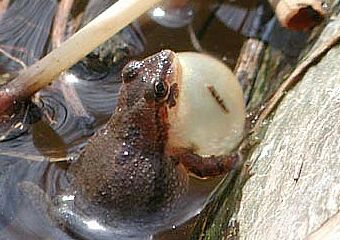
NORTHERN LEOPARD FROG
A common brown or green frog marked with distinct, rounded, black spots. It is also called the "meadow frog" because it wanders well away from the water. They are usually found along grassy ditch banks.

GREEN FROG
The call, which sounds like a plucked banjo string, is heard throughout mid summer in marshes, streams and permanent ponds. The tadpoles do not transform into frogs until the second year. Green Frogs are the most common amphibian attracted to backyard ponds.
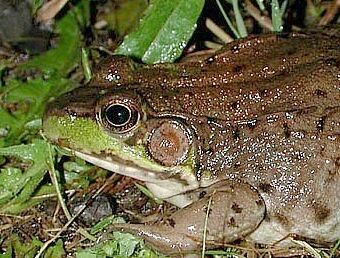
BULLFROG
Bullfrogs prefer larger bodies of water than the other frog species. The few records for the park are probably individuals released by park visitors.
TURTLES
COMMON SNAPPING TURTLE
Snapping Turtles are most often seen in June when the large females emerge from ponds to lay their eggs. Although aggressive when cornered on land this turtle is shy in water. They are listed as "Special Concern" in Ontario.
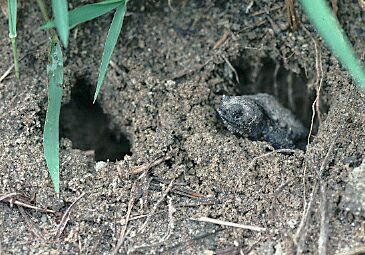
COMMON MUSK TURTLE
This small turtle gets its name from the skunk-like odour it releases when frightened or disturbed. This small turtle frequently goes unnoticed because it seldom basks. It is an Threatened Species in Ontario.
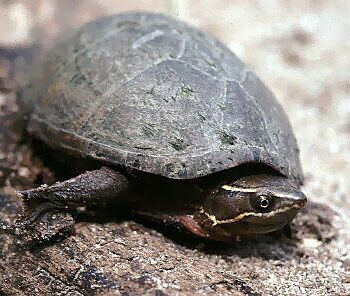
SPOTTED TURTLE
Spottted Turtles have been recorded twice from Ojibway but these are likely released animals that were captured elswhere. One was recorded from Fighting Island in 2008. It is an Endangered Species in Ontario.
MIDLAND PAINTED TURTLE
The turtle most likely to be encountered by park visitors in the shallow water of ponds, marshes, ditches, creeks and streams in the Ojibway area.
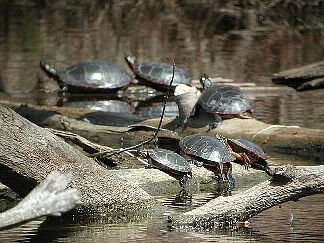
RED-EARED SLIDER
Many turtles are released in the park each year. Red-eared Slider, the common "pet store" turtle, along with more exotic species such as Peninsula Cooter, Eastern Box Turtle and Three-toed Box Turtle have been found at Ojibway.
MAP TURTLE
This species is usually found in lakes and large cattail marshes. Map Turtles can often be seen basking on floating tree stumps at the mouth of Turkey Creek. They are listed as "Special Concern" in Ontario.
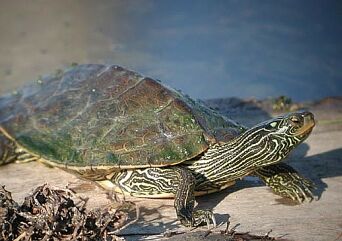
BLANDING'S TURTLE
This medium-sized turtle is easily recognized by its bright yellow chin and throat and extremely long neck. It is sometimes called a "semi-box turtle" because of its high-domed shell and partially hinged plastron. Blanding's Turtles are a Threatened Species in Ontario and protected under Ontario's Endangered Species Act.
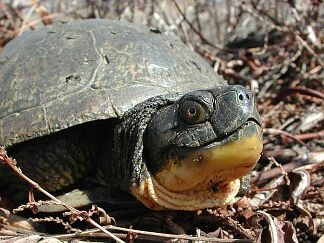
EASTERN SPINY SOFTSHELL
The first local record for this rare turtle occurred in 2002. A large female was found laying eggs along the banks of Turkey Creek in LaSalle. Spiny Softshells are listed as a Threatened Species in Ontario and are seldom seen away from their usual haunts along the Thames and Sydenham Rivers in southwestern Ontario.
LIZARDS
FIVE-LINED SKINK
There have been no records of this small endangered lizard for the Ojibway area since the early 1970's. Skinks prefer open sandy areas which have largely disappeared in the local area.

SNAKES
EASTERN GARTERSNAKE
Gartersnakes have been recorded for every month of the year at Ojibway. This species usually emerges from hibernation in late March. The colouring is extremely variable and may include a ground colour of olive, green or dark brown. The yellow stripes vary in brightness and are sometimes mixed with red (hence the local name "red racer"). Black (melanistic) individuals are rare. There are even a few records of albino individuals from the Windsor area.
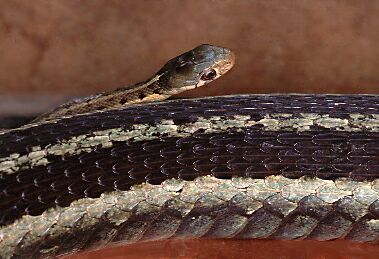
BUTLER'S GARTERSNAKE
Often confused with the Eastern Gartersnake, Butler's is smaller and more brightly coloured with a proportionately smaller, shorter head. The lateral stripe is located higher on the sides of the body in the Butler's Gartersnake. It also has a distictive habit of wrapping its tail around fingers when handled. There is one local record of an albino individual. The range of this snake closely coincides with that of eastern tallgrass prairie in North America. This snake is an Endangered Species in Canada, found only in three areas of southwestern Ontario. It is protected under Ontario's Endangered Species Act.
NORTHERN WATERSNAKE
The watersnake is never found far from lake shores, streams, ponds and marshes. In this area it is found in marshy areas along the Detroit River. Although capable of inflicting a lacerating bite when handled, this species will rapidly glide away when approached. The Queen Snake is also found along the Detroit River, but this much less common species has not been recorded within the Ojibway area.
NORTHERN RED-BELLIED SNAKE
This is Canada's smallest snake. It is generally dark grey or reddish brown with a distinctively bright red belly. During the day, this snake conceals itself under rocks, boards or other ground cover.
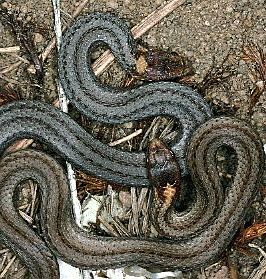
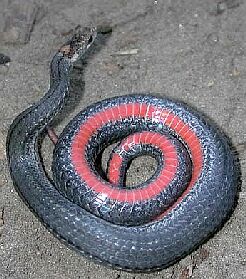
NORTHERN BROWNSNAKE
This snake is small and inconspicuous, attaining a maximum length of about forty centimetres. It spends most of the day in hiding and emerges from cover in late afternoon to feed on slugs, snails and earthworms.
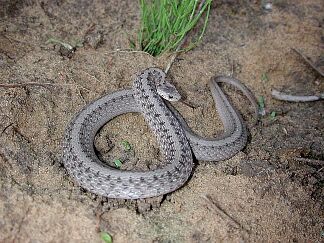
SMOOTH GREENSNAKE
This strikingly beautiful little snake gets its name from its satiny smooth green scales. It inhabits grass fields, clearings and open woods, feeding primarily upon spiders and insects. There are only two local records for this species.
EASTERN HOGNOSE SNAKE
The only record of this rare snake for the Ojibway area is from the early 1970's. It was probably an introduced individual. It is not unusual to find non-native wildlife in urban areas. Exotics such as California Kingsnake, Royal Python and Boa Constrictor have been found locally.
EASTERN MILKSNAKE
Although fairly common in much of southern Ontario this species is rare in Essex County. There are only two records for the Ojibway area.
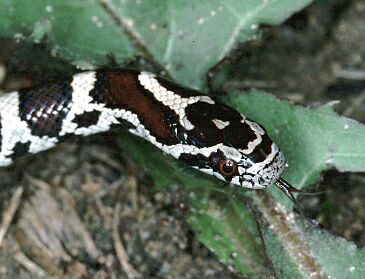
The Foxsnake is the largest snake in the area, attaining lengths of almost two metres. When captured, this snake may secrete a strong smelling musk which suggests the odor of fox. This species is often mistakenly identified as an Eastern Massasauga Rattlesnake or a Copperhead (Copperheads do not occur in Canada). When disturbed fox snakes imitate a rattler by vibrating the tip of their tail. However, this Endangered Species is harmless and protected under Ontario's Endangered Species Act.
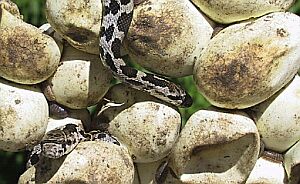
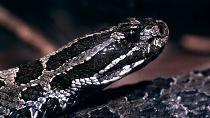 EASTERN MASSASAUGA RATTLESNAKE
EASTERN MASSASAUGA RATTLESNAKE
This is the only venomous snake found in Ontario. Although the venom is potent, its small size (usually about 50 - 70 centimetres) and retiring habits make it a minor risk to humans. Ojibway supports the only remaining population in extreme southwestern Ontario. This snake has been officially designated as a Threatened Species and is protected under Ontario's Endangered Species Act.
Photographs © P.D. Pratt, Russ Jones
